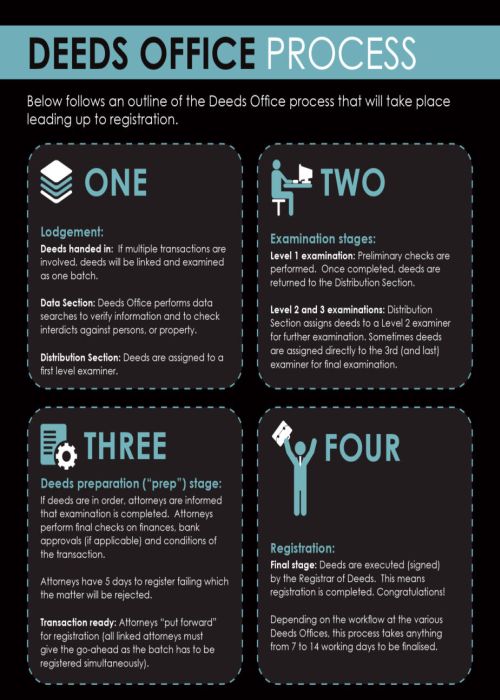When do you become the registered owner of a property?
Despite common belief, the finish line when buying and/or selling property is not reached when entering into an agreement of sale or even when signing the transfer documents at the conveyancing attorney's offices. In fact, the finish line is only crossed once the transfer of the property has been processed and registered at the relevant Deeds Office.
What role does the Deeds Office play and how does it all work?
The Deeds Office is a branch of the Department of Agriculture, Land Reform and Rural Development and is responsible for the accurate examination, registration and record-keeping of all property transactions. There are 11 Deeds Offices spread throughout the country, based in Pretoria, Johannesburg, Polokwane, Cape Town, Pietermaritzburg, Bloemfontein, Kimberley, Vryburg, Nelspruit, King William's Town, and Umtata.
Once the conveyancing attorney has finalised the necessary documentation (referred to as the deeds), these are handed in at the lodgement counter of the Deeds Office. At this point, the deeds are scanned by the Deeds Office officials using a barcode tracking system which allows the conveyancing attorney to follow the transaction's progress within the Deeds Office. This is the first step in the registration process and is referred to as lodgement.
It is often the case that a transaction involves several components, such as the transfer of a property and the simultaneous registration of a mortgage bond. These deeds are to be linked and examined as one batch. Once the deeds have been linked, they are handed over to the Data Section, which is responsible for performing searches to verify information and to check whether there are any interdicts noted against the persons or entities involved in the transaction, as well as the property.
The deeds are now ready to be sorted and distributed for examination. There are 3 levels of examination, namely:
- Level 1 Examination: The deeds are allocated to junior examiners, who perform the preliminary checks. Once completed, the deeds are returned to the Distribution Section.
- Level 2 Examination: The deeds are distributed amongst senior examiners for further examination. The examiners consider the queries raised by the junior examiners and indicate whether the deeds are to be passed or rejected. The deeds are returned to the Distribution Section before moving to the next level of examination.
- Level 3 Examination: The final level of examination is monitored by an assistant Registrar of Deeds, ultimately deciding whether the deeds are to be passed or rejected. The deeds are sorted accordingly.
If the deeds are rejected, they are sent to the Deliveries Section and later collected by the conveyancing attorney. The conveyancing attorney will then address the queries raised by the Deeds Office and arrange for the re-lodgement of the deeds.
The deeds that are found to be in order and passed will move to the next step in the registration process, being the preparation ("prep") stage. The conveyancing attorneys will, at this stage, make the final arrangements necessary to register the matter. These arrangements include obtaining the bank's approval, should a bond be registered or cancelled, as well as ensuring that all the finances and contractual conditions are in order.
The conveyancing attorneys are granted 5 working days, unless specified otherwise, within which registration must take place. All of the conveyancing attorneys linked in the same batch are required to give their go-ahead in order for registration to take place, failing which the matter will be rejected. Just before registration, the Data Section performs final checks to ensure that no new interdicts have been noted against the persons, entities or property since lodgement. If everything is in order, the deeds are sent for execution by the conveyancer in the presence of the Registrar of Deeds and registration takes place.

Once registered, the Deeds Office attends to the following administrative tasks to ensure that the deeds are in order and correctly recorded:
- The Numbering Section allocates a unique number to each deed, the deed is dated with the registration date, and the Registrar of Deed's official seal is affixed thereto;
- The property transaction is captured on the Deeds Registration System by the Data Section to ensure that the land register is kept up to date;
- A final check of the deeds is performed; and
- The deeds, and accompanying documents submitted to the Deeds Office, are scanned by the Microfilming Section as part of the Deeds Office's record keeping system, whereafter the original deeds are sent to the Delivery Section for collection by the conveyancing attorney.
Finally, the conveyancing attorney arranges for delivery of the original deeds to the client. In the event of a mortgage bond being registered, both the mortgage bond and title deed are sent to the bank for safekeeping. Once the mortgage bond is cancelled, the registered owner will be entitled to take possession of the original title deed.
There is no question that South Africa has an intricate and formidable land registration system, with title security at the forefront. It should come as no surprise that it is regarded as one of the best in the world. Our team of experienced conveyancing attorneys are available to guide you through this registration process.
The content of this article is intended to provide a general guide to the subject matter. Specialist advice should be sought about your specific circumstances.
We operate a free-to-view policy, asking only that you register in order to read all of our content. Please login or register to view the rest of this article.


